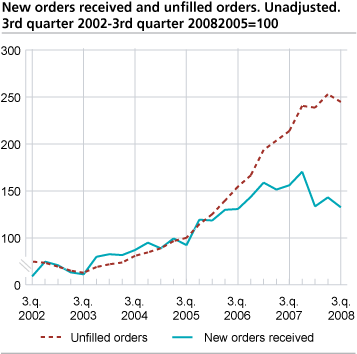Content
Published:
This is an archived release.
Less new orders received in industry
The volume of new orders received was significantly lower in the third quarter of 2008 than in the corresponding quarter in 2007. Total stocks in industry were still at a high level historically.
The number of new orders received went down by 15 per cent from the third quarter of 2007 to the third quarter of 2008. Figures from the transport equipment industry contributed to this development. The total stock of new orders showed an increase of 14.5 per cent in the same period, but the growth seems signs of levelling out.
| Industrial Classification | New orders received (trend)1 | Unfilled orders (original series) Q3 2007- Q3 2008 |
|||||||||||||||||||||||||||||||||||||
|---|---|---|---|---|---|---|---|---|---|---|---|---|---|---|---|---|---|---|---|---|---|---|---|---|---|---|---|---|---|---|---|---|---|---|---|---|---|---|---|
| Q1 2008- Q2 2008 |
Q2 2008- Q3 2008 |
||||||||||||||||||||||||||||||||||||||
| Total | -11.0 | -4.4 | 14.5 | ||||||||||||||||||||||||||||||||||||
| Basic Chemicals | -16.7 | -18.0 | 37.4 | ||||||||||||||||||||||||||||||||||||
| Basic Metals | -21.5 | -16.8 | -25.9 | ||||||||||||||||||||||||||||||||||||
| Machinery and Equipment | 11.3 | 6.8 | 42.1 | ||||||||||||||||||||||||||||||||||||
| Oil Platforms and Modules | -22.8 | -11.8 | 23.2 | ||||||||||||||||||||||||||||||||||||
| 1 | Estimated annual changes in trend series, based on change in percentage from previous quarter, converted to annual growth. |
Tables
Contact
-
Statistics Norway's Information Centre
E-mail: informasjon@ssb.no
tel.: (+47) 21 09 46 42

